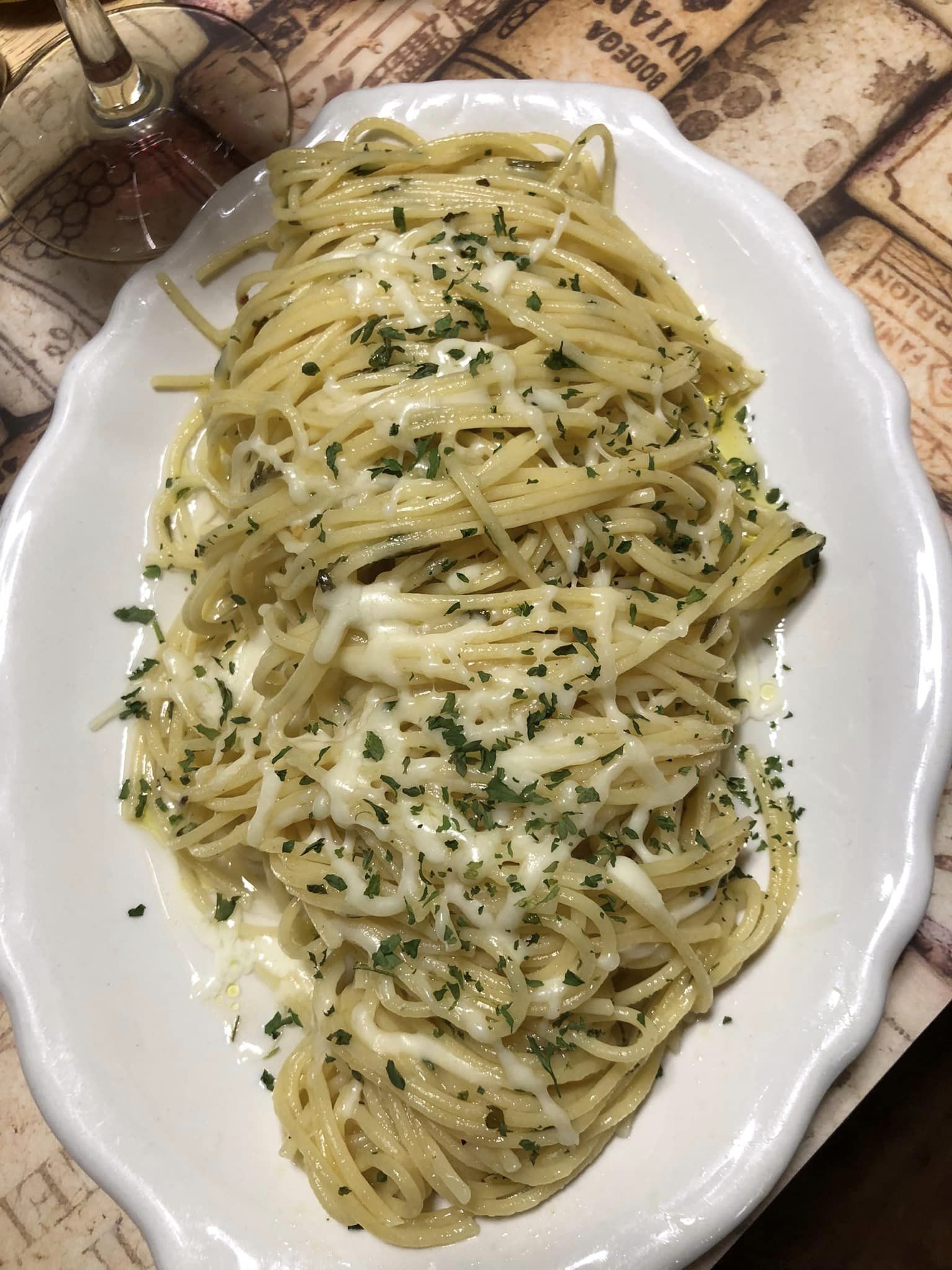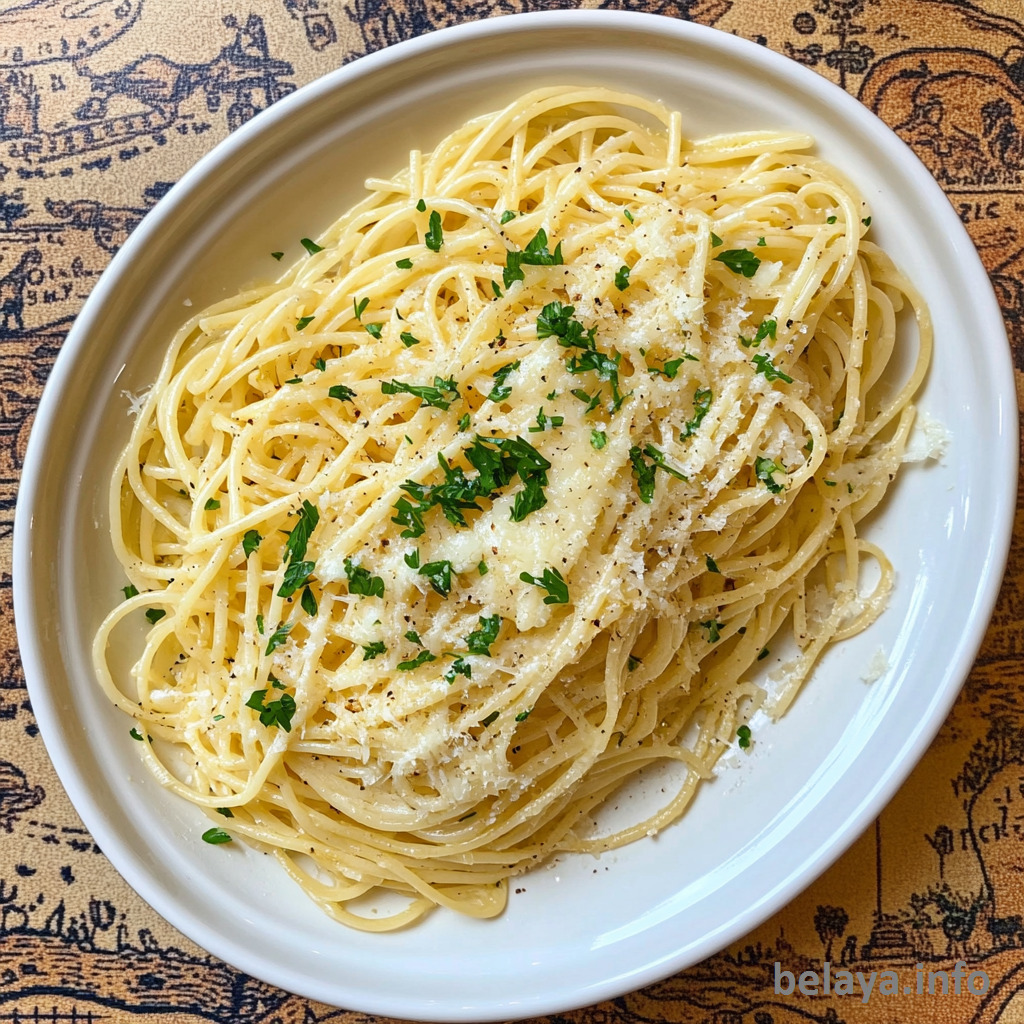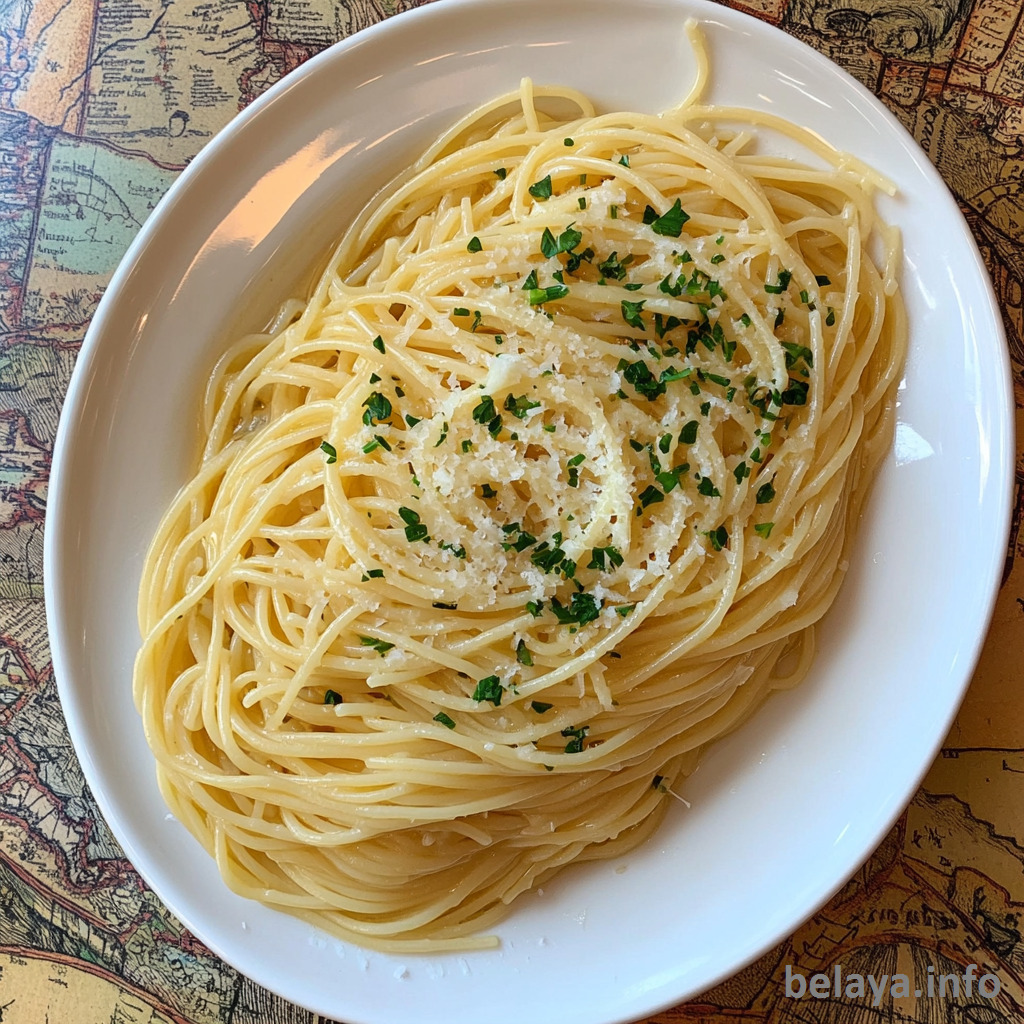Pasta Aglio e Olio
Simple in ingredients yet rich in character, Pasta Aglio e Olio is a timeless Italian classic that proves elegance doesn’t require complexity. Rooted in the traditions of Naples, this dish transforms pantry staples—garlic, olive oil, and spaghetti—into something deeply satisfying.
The golden slivers of garlic infuse the oil with warmth, while a touch of red pepper flakes adds a gentle heat that lingers. Brightened with lemon juice, fresh parsley, and a generous sprinkle of Parmesan, every bite strikes a perfect balance between richness and freshness.
It’s comfort food at its most honest—humble, soulful, and incredibly flavorful.

Why People Will Love This Pasta Aglio e Olio Recipe:
Elegantly simple, yet deeply flavorful: With just a handful of ingredients, this dish captures the essence of Italian cooking—letting quality olive oil, golden garlic, and al dente pasta shine in every bite.
Quick and comforting: It comes together in under 30 minutes, making it the perfect meal for busy weeknights that still delivers warmth, satisfaction, and soul.
Balanced and versatile: The heat of red pepper flakes, the brightness of lemon, the freshness of parsley, and the richness of Parmesan create a layered flavor profile that appeals to a wide range of palates.
Pantry-friendly ingredients: All the components are kitchen staples—making it budget-conscious and ideal for last-minute meals without sacrificing quality.
Customizable to your taste: Whether you want it spicier, cheesier, or brighter with extra lemon, the recipe is endlessly adaptable while staying true to its rustic roots.
A timeless Italian classic: There’s beauty in the tradition—Aglio e Olio has been beloved for generations because it represents the comfort of home, the pleasure of simplicity, and the art of restraint.

Key Ingredients:
Dried spaghetti provides the perfect foundation—its firm, chewy texture captures every drop of infused oil and clings to the seasoning with satisfying bite.
Extra-virgin olive oil is the soul of this dish, offering richness, fruity depth, and a silky coating that binds all the ingredients in harmony.
Fresh garlic, thinly sliced, is slowly toasted until golden, releasing a mellow, nutty aroma that transforms the entire dish into a fragrant, savory experience.
Crushed red pepper flakes add subtle heat that builds gradually, awakening the palate and balancing the oil’s richness with a gentle, fiery kick.
Fresh parsley brings a pop of color and herbal brightness, cutting through the fat and adding freshness to each forkful.
Lemon juice introduces a light, tangy contrast, lifting the overall flavor and making the dish feel vibrant and well-rounded.
Parmesan cheese, freshly grated, adds saltiness and umami depth, melting slightly into the pasta and enhancing every flavor without overwhelming the simplicity.

Expert Tips:
Use high-quality extra-virgin olive oil: This is not just a cooking fat—it’s the core flavor of the dish. Choose an olive oil with a smooth, fruity, or peppery profile to give the pasta depth and aroma.
Slice garlic thin and evenly: Uniform slicing ensures the garlic cooks consistently. Too thick, and it stays raw inside; too thin, and it burns quickly. You want it light golden—not brown—for a toasty, mellow sweetness.
Control the heat while cooking garlic: Always cook garlic on medium-low heat to allow slow flavor infusion into the oil. Rushing this step can result in bitterness, which will overpower the delicate balance of the dish.
Reserve starchy pasta water wisely: The pasta water helps bind the oil to the spaghetti, creating a silky emulsion rather than a greasy coating. Add gradually while tossing to achieve the perfect texture.
Toss pasta in the pan, not in a bowl: Tossing the spaghetti directly in the garlic oil over gentle heat helps it absorb the flavors and develop that authentic, glossy finish.
Finish off the heat: After tossing, remove the pan from the heat before adding parsley, lemon juice, and Parmesan. This prevents the herbs from wilting too much and keeps the cheese from clumping or becoming stringy.
Don’t overdo the Parmesan: Aglio e Olio traditionally doesn’t rely on heavy cheese. A light grating enhances the umami without masking the clean, garlicky base.

How to make Pasta Aglio e Olio
Ingredients
1 pound dried spaghetti
¾ cup extra-virgin olive oil
12 large garlic cloves, cut into thin slivers
2 teaspoons crushed red pepper flakes, plus more for serving
Kosher salt and black pepper
⅓ cup fresh parsley, finely chopped
2 tablespoons fresh lemon juice, plus lemon wedges for serving
½ cup freshly grated Parmesan cheese, plus more for serving
Instructions:
Step 1:
Bring a large pot of salted water to boil and add spaghetti, cooking until al dente, 8 to 10 minutes.
Drain, reserving 1 cup pasta water.
Step 2:
Meanwhile, in a large pan, heat olive oil over medium-low.
Add garlic and cook, stirring frequently, until golden brown, about 3 minutes.
Add crushed red pepper flakes and a healthy pinch of salt and pepper.
Add drained spaghetti to pan and toss, adding pasta water, until spaghetti is thoroughly coated.
Step 3:
Remove pan from heat, add parsley, lemon juice, and Parmesan and toss well.
Check for flavor, adding more salt if necessary.
Garnish with more Parmesan, lemon wedges, and crushed red pepper flakes.

Important Notes When Making Pasta Aglio e Olio
This dish is all about timing and technique: With so few ingredients, each one must be cooked thoughtfully. Overcooked garlic, under-salted pasta water, or mismanaged oil can quickly throw off the delicate balance.
Salt your pasta water generously: Since there’s no sauce to hide behind, the pasta itself must be properly seasoned. Think of the pasta water as your first opportunity to build flavor.
Do not brown the garlic too much: Garlic goes from golden to bitter very quickly. Remove it from the oil immediately if it begins to darken too fast, or lower the heat to prevent burning.
The pasta water creates the sauce: This dish doesn’t use cream or butter—emulsified pasta water and olive oil make the “sauce.” Without enough starchy water, the oil will separate and coat the noodles instead of clinging to them.
Balance heat and brightness: The red pepper flakes offer subtle fire, while the lemon juice cuts through the richness of the oil. These contrasting elements should feel balanced, not dominant.
Use fresh herbs and cheese only at the end: Adding parsley and Parmesan too early dulls their impact. Add them off heat, allowing their flavor and texture to remain distinct and fresh.
Respect its simplicity: The beauty of Aglio e Olio lies in restraint. Avoid adding too many extras—this dish celebrates how much flavor can come from so little when treated with care.
How to Enjoy Pasta Aglio e Olio After Cooking
Serve Immediately While Hot
Pasta Aglio e Olio is best served right out of the pan. The heat helps the garlic oil stay fluid and glossy, coating the spaghetti perfectly. Letting it sit too long can cause the oil to separate and the pasta to dry out.
Plate Thoughtfully
Use shallow, warm bowls or plates to retain heat and allow for beautiful presentation. Twirl the pasta into neat nests using tongs or a carving fork for a more elegant, restaurant-style look.
Garnish for Flavor and Contrast
Top each serving with:
Fresh parsley – for a vibrant, herbal finish
Grated Parmesan – for added umami richness
Extra crushed red pepper flakes – for a personalized touch of heat
Lemon wedges – to squeeze over for added brightness and acidity
These garnishes aren’t just aesthetic—they enhance the flavor and balance the richness of the olive oil.
Pair with Light Sides
To keep the focus on the pasta’s subtle depth, serve it with:
A crisp green salad with lemon vinaigrette
Roasted or steamed vegetables, like asparagus or zucchini
Toasted rustic bread to mop up the garlicky oil
Avoid heavy or creamy sides that would compete with the clean, minimalist flavor of the pasta.
Complement with the Right Drink
Pair with:
A dry white wine (like Pinot Grigio or Vermentino)
Sparkling water with lemon for a refreshing, palate-cleansing option
Or a light-bodied red wine like Chianti, if adding seafood or protein
Store and Reheat with Care
If you have leftovers:
Store in an airtight container in the fridge for up to 2 days
Reheat in a skillet with a splash of hot water or fresh olive oil to revive texture—avoid microwaving, which dries the pasta and dulls the garlic flavor
Reinvent the Leftovers
Use cold leftovers as a base for:
A pasta salad with cherry tomatoes, olives, and arugula
A quick side dish alongside grilled chicken or shrimp
A base for a fried egg and a sprinkle of chili crisp for a fusion brunch idea

Nutrition Information:
For one serving of Pasta Aglio e Olio, assuming the recipe makes 6 servings:
Calories: 480 kcal | Total Fat: 21.5 g | Saturated Fat: 4.1 g | Monounsaturated Fat: 14.2 g | Polyunsaturated Fat: 2.2 g | Cholesterol: 6 mg | Sodium: 220–300 mg (depending on salt and cheese) | Total Carbohydrates: 56 g | Dietary Fiber: 3.2 g | Sugars: 2.1 g | Protein: 13 g

Frequently Asked Questions:
Can I make Pasta Aglio e Olio without cheese?
Yes. Traditional Aglio e Olio is actually made without cheese. While Parmesan adds extra depth and umami, the dish is flavorful enough on its own thanks to the garlic, olive oil, and red pepper flakes. Skipping the cheese also makes it vegan-friendly.
What type of pasta works best for this dish?
Spaghetti is the classic choice for its ability to hold onto the oil-based sauce, but linguine, fettuccine, or even angel hair can be used. The key is to use a long, sturdy noodle that can absorb and carry the garlic oil evenly.
How do I keep the garlic from burning?
Cook the garlic over medium-low heat and stir frequently. Once it turns light golden, remove it from the heat or reduce the flame immediately. Burnt garlic turns bitter and can ruin the delicate balance of the dish.
Is it necessary to use fresh lemon juice?
Yes, ideally. Fresh lemon juice brightens the dish and balances the richness of the olive oil. Bottled lemon juice lacks the same vibrant acidity and can introduce a processed flavor.
Can I add protein to make this a more complete meal?
Absolutely. While Aglio e Olio is often served as a standalone dish, you can add grilled shrimp, seared scallops, sautéed mushrooms, or roasted chickpeas for added protein—just be sure not to overpower the subtle flavors of the base.
How do I know when the garlic is perfectly cooked?
The garlic is ready when it turns a light golden color and smells fragrant—not burnt. This usually takes about 2–3 minutes on medium-low heat. If it gets too dark, it will become bitter and overpower the dish.
Why is my pasta oily instead of silky and coated?
If the pasta seems greasy, you likely missed the emulsion step. Add reserved pasta water gradually while tossing the pasta in the pan. The starches in the water bind with the oil, creating a smooth, glossy coating instead of a slick layer.
When should I add the parsley and lemon juice?
After removing the pan from heat. This preserves the parsley’s fresh, herbal flavor and prevents the lemon juice from becoming too sharp or bitter from heat exposure.
Can I make this dish in advance?
Pasta Aglio e Olio is best enjoyed fresh, as it tends to dry out when reheated. If you must prepare in advance, store the pasta and oil separately and reheat gently with a splash of hot water or fresh olive oil to revive the texture.
What’s the best way to avoid overcooking the pasta?
Start tasting your pasta about 1–2 minutes before the box’s suggested cook time. Drain it while it’s still al dente, as it will finish cooking slightly when tossed with the hot oil in the pan.